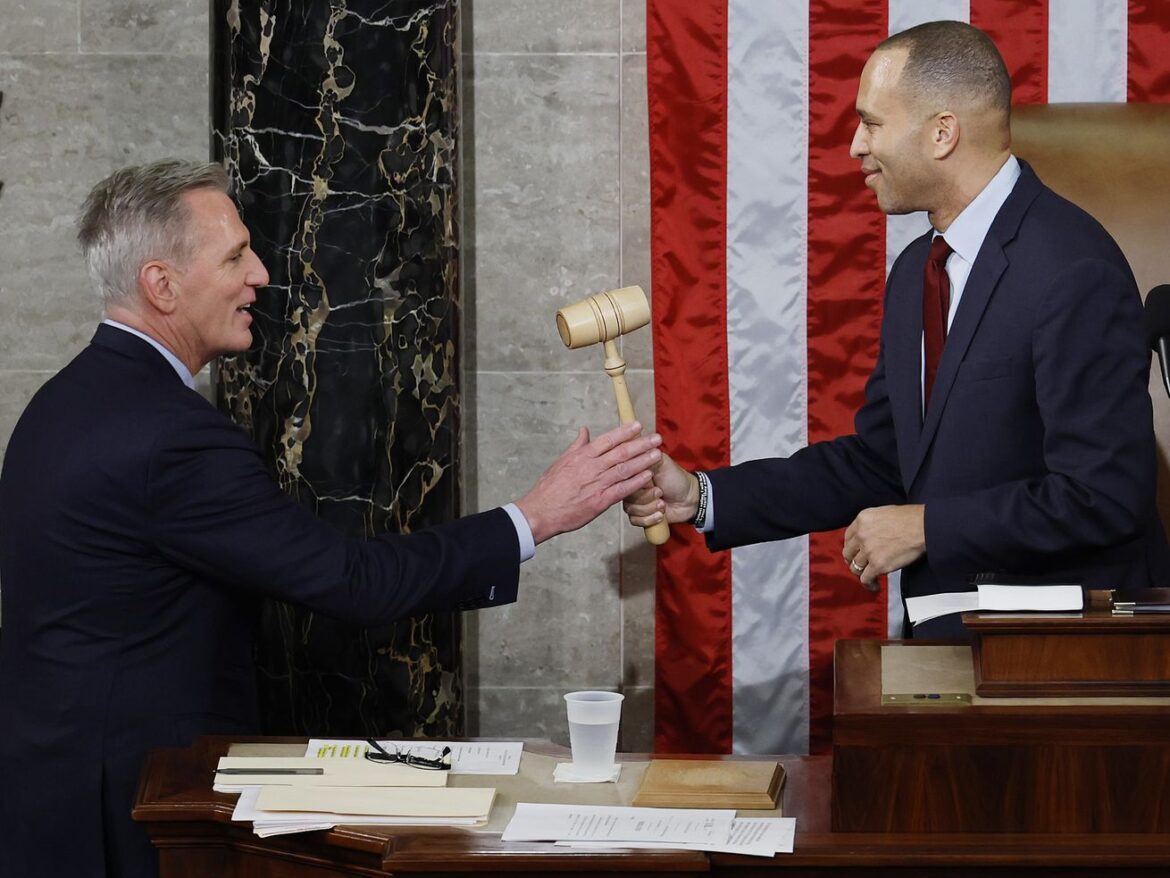House Democrats’ long-shot plan to solve the debt ceiling crisis, explained.
On Friday, Republicans walked away from negotiations between the White House and Speaker Kevin McCarthy on raising the debt ceiling. It’s unclear whether this is just a negotiating tactic or a sign of deep problems with reaching a deal. But if no deal can be reached with the GOP, a disastrous default on the nation’s debt may result.
So House Democrats have been moving ahead with their long-shot backup plan: a discharge petition.
Basically, a discharge petition forces the House to take action on a particular bill — say, a bill increasing the debt limit — even if the speaker or key committees don’t want to act.
The theory here is that maybe enough reasonable Democrats and Republicans could join together to pass a debt ceiling increase, if they got to vote on one. But McCarthy might not allow them to vote on such a bill if it’s strongly opposed from the right, since that would risk his speakership. So this would go around him.
But like any petition, a discharge petition needs signatures — 218 signatures, which would be a majority of the House. Democrats announced Wednesday that they’d begin collecting those signatures, and 210 of them have already signed on. Three more Democrats haven’t yet signed, but if they do, five Republicans would also be necessary for the petition to succeed.
At the moment, that seems very unlikely. A discharge petition is a bold challenge to the speaker’s authority, effectively wrenching control of the chamber out of his hands. In this case, it would also undercut his negotiating strategy, since he is purportedly trying to win concessions Republicans want. The few moderate Republicans who’d seem most likely to sign on have all solidly backed McCarthy’s strategy of negotiating with the White House. They will not split from him lightly.
It isn’t even clear yet what bill Democrats would want to force action on — they’ve used placeholder text that could be changed to their liking later. Theoretically, it could be a “clean” debt ceiling increase, or, if there is a Biden-McCarthy deal that the GOP right blocks, the bill could be that deal.
All we know for sure is that the “X-date” — the date the “extraordinary measures” the Treasury Department is currently using to keep paying its bills will no longer work — is approaching, and could come as soon as June 1. If the nation is truly on the brink of disaster, and the House GOP is mired in chaos and infighting, Democrats hope they could find five Republicans to sign their petition. But for now, the White House is still hoping for a deal that would avoid that path altogether. The question is whether Republicans will play ball.
When have discharge petitions succeeded?
Through much of the House’s history, the chamber’s members have battled over who should have control over the chamber’s agenda — what gets brought up for a vote and when.
Should it be the speaker? Should it be key committee chairs? Or should a disparate group of rank-and-file members be able to have a voice?
By 1910, old-guard Republican Speaker Joseph Cannon had centralized power in his hands to an unprecedented degree. But eventually enough Progressive Republicans joined with Democrats and revolted, forcing Cannon to make concessions limiting his authority. One of those changes to House rules established the discharge petition, though the details of how it works changed in subsequent decades.
Frequently threatened and attempted, discharge petitions have rarely succeeded. In 1938, it was used to get the Fair Labor Standards Act past the conservative House Rules Committee. In 1963, Democrats used it to force that same committee to hold hearings on civil rights (the committee chair caved before 218 signatures were lined up). In 2002, it got campaign finance reform to the floor of the House, despite Republican Speaker Dennis Hastert’s reluctance.
Interest groups have wielded it to circumvent recalcitrant committee chairs, too. Soft drink distributors sought and won an antitrust exemption in 1980, the banking industry rolled back a new tax withholding law in 1983, the National Rifle Association got a gun rights bill through in 1986, and the Export-Import Bank got reauthorized in 2015, all due to discharge petitions to circumvent committee chairs who opposed those measures.
But these efforts often fall short. The last big discharge petition battle was over the Deferred Action for Childhood Arrivals (DACA) program, which provided temporary deportation protections for some unauthorized immigrants who came to the US as children. Moderate Republicans wrote a bill and joined with Democrats to get 216 signatures on a discharge petition for it — just two short of the magic number. But Speaker Paul Ryan then acted to prevent anyone else from going wobbly, cutting a deal to hold a vote on a more conservative bill instead.
The lesson there is that undercutting your own party’s speaker is a momentous move in these polarized times. Then again, the debt ceiling is an issue with potentially momentous consequences.
Why a discharge petition looks so unlikely now
The prospects that a discharge petition will get us out of this crisis are slim, but Democrats think it’s worth a shot.
One complication is that there are various procedural and timing restrictions with how long it would take to actually force a vote. Democrats ran out the clock on much of this already through a creative strategy (they introduced their bill in an under-the-radar way back in January), but they still need to actually get their 218 signatures, and then there are further procedural steps that could take weeks after that.
It’s not an accident the process is cumbersome — it’s meant as a last resort rather than a first resort. But in this situation, delays could well take us past a debt ceiling breach.
The first problem will be actually getting those 218 signatures — meaning, those five Republicans.
Back in January 2023, that looked potentially promising. The right flank of the GOP had spent days tormenting McCarthy as he struggled to line up the votes to become speaker. It looked like McCarthy could be fatally hamstrung by concessions he’d made to the right — that he could lose his speakership if he didn’t cater to every whim of the further right members of the Freedom Caucus.
Eventually, the thinking went, moderate Republicans might grow exasperated enough at their colleagues’ extremism and irresponsibility to join with Democrats on raising the debt ceiling.
So far, that isn’t what’s happened. Instead, the House GOP united around one plan that they passed through the House, and GOP moderates are fully backing McCarthy. For a Republican, then, joining a discharge petition would be a major betrayal, undercutting their party leader’s negotiating strategy and reducing the GOP’s leverage over Biden right when talks have gotten serious.
The current pause in talks may well be a tactic aimed at getting more Democratic concessions, so moderate Republicans wouldn’t want to undercut that. The question is what they will do if the talks are truly deemed to have failed — either because there’s no deal, or because the House GOP right rejects a deal.
Let’s start with the “no deal” scenario. The outcome there depends on who moderate Republicans end up blaming for the failure. If they think there was a good offer from Biden that their far-right colleagues are being ludicrously obstinate in rejecting, then maybe they’d sign on to a discharge petition, if Democrats alter their underlying bill to include parts of that offer. But if moderate Republicans blame Democrats for being obstinate, they probably won’t be in the mood to play ball with them.
Then there’s the scenario where McCarthy does strike a deal, but the GOP right revolts and he feels unable to put the bill up for a vote without risking his own speakership. In that case, Democrats could change their underlying bill to the McCarthy-Biden deal, and ask for Republican signatures on their petition to advance it.
In both instances, for the petition to have any chance of success, GOP moderates must blame the far right, not Democrats, for the crisis.
We may end up in one of these scenarios. For now, though, there’s another reason House Democrats think this effort is worth pursuing. The very existence of the discharge petition option, some told the New York Times, could empower moderate Republicans in the party’s own internal negotiations and force a more reasonable deal. That is: Some moderates could tell their further-right colleagues, “If you don’t back down, we’ve got somewhere else we could go.”
As with any weird congressional procedural trick, it’s unlikely the discharge petition will end up saving the day. And there are enough messy complications, and an ominous deadline, that a deal would be far preferable. But, just in case, it’s worth having a backup plan — even if things would have to get really grim before it could work.
Update, May 19, 2:35 pm: This article was originally published on May 17 and has been updated with news that negotiations have stalled.



